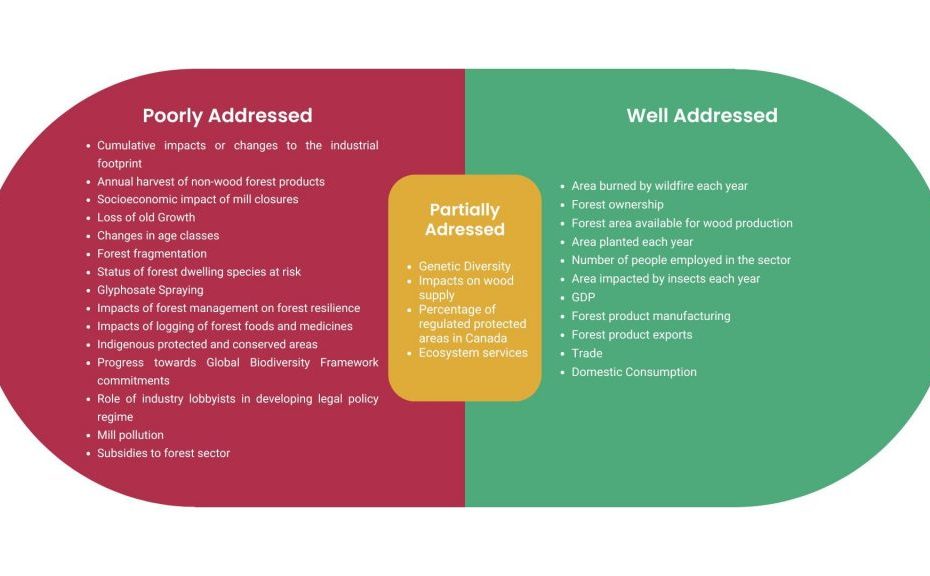Forest ecosystems play a vital role in Canada’s environment, economy, and cultural identity, and their conservation is crucial in the fight against climate change. Roughly Yet, federal and provincial governments claim Canada’s forests are sustainably managed through reporting that omits damage caused by our current approach to industrial logging.
Canada presents itself as a global leader in sustainable forestry, pointing to its membership in the , a coalition overseeing 90% of Earth’s temperate and boreal forests. This group sets international standards for measuring and reporting forest health, requiring transparent tracking of sustainability progress.
However, the State of Canada’s Forests: Annual Report (SOF report) consistently fails to meet these standards. An alternative analysis, Advertising or Accountability? A Critical Review of Canada’s State of the Forests Report exposes these reporting gaps and reveals why they matter. Here’s what every Canadian should know about how our governments are not properly reporting on the state of our forests.
How Government Reporting Misleads
Instead of painting a holistic picture of Canada’s forests based on science and evidence, the SOF report misleads Canadians through selective reporting, which fails to meet the standards set by the Montréal Process.
The SOF report’s selective data and misleading figures serve to protect industry at the expense of forest health. The report focuses on economic indicators while obscuring the impact of industrial activity on ecosystem health. This raises questions about how much of Canada’s forest policies are shaped by Indigenous knowledge, independent scientists or industry lobbyists.
Here are some key takeaways from the critical review of Canada’s SOF report:
An overview of the strengths and weaknesses of the SOF report, adapted from a graphic in Advertising or Accountability? A Critical Review of Canada’s State of the Forests Report.
Hiding Forest Destruction in Plain Sight
For instance, while the Montréal Process requires detailed data on forest ecosystems including type, age, and location, Canada’s SOF report mainly tracks total forest area. In practice, this means recent clearcuts and ancient old-growth forests are both counted simply as “forest.” This oversimplification hides critical ecological differences and makes it much harder to monitor the conservation of old-growth forests. That’s a serious problem, given that mature forests are among our most powerful natural defenses against climate change and are much more biodiverse than the young replanted forests replacing them.
When Industry Impact Gets Called “Natural”
When discussing forest ecosystem health, the SOF report misleads by heavily emphasizing natural disturbances like wildfires while downplaying industrial logging’s role in degrading forest health. Logging makes forests more vulnerable to fires, pests, and droughts by replacing diverse ecosystems with fragile monocultures, fragmenting habitats, and altering soil and water systems. These industrial impacts are rarely acknowledged. By framing disturbance trends as primarily “natural,” the report obscures how human activity intensifies these very threats.
Northern Ontario © Jeremy Rempel CC BY-ND 2.0
Hiding Logging’s Carbon Footprint
The SOF report also misleadingly portrays industrial logging as carbon neutral or even carbon-negative, despite evidence showing it is one of Canada’s highest emitting sectors. The government’s reporting systematically undercounts logging emissions by excluding wildfire-related CO₂ releases while claiming credit for carbon absorbed by post-fire regrowth, artificially inflating the sector’s climate benefits. These accounting gaps, criticized by auditors and scientists, allow the government to frame logging as “sustainable” despite evidence showing it rivals oil sands emissions.
A Call for Honest Forest Stewardship
While Canada has made significant commitments to forest conservation, the critical review of Canada’s SOF report reveals some worrying trends in the health of our forests. In a nation where wilderness is central to our identity, leaders should be doing far more to safeguard these vital forests for future generations. The forest industry’s economic well-being is equally tied to healthy and sustainably managed forests. It is imperative that our governments do a better job of protecting forests for the health and wellbeing of future generations.
Read the full critical review.
Resources
The post The True State of Canada’s Forests: What Government Reports Leave Out appeared first on Ontario Nature.
